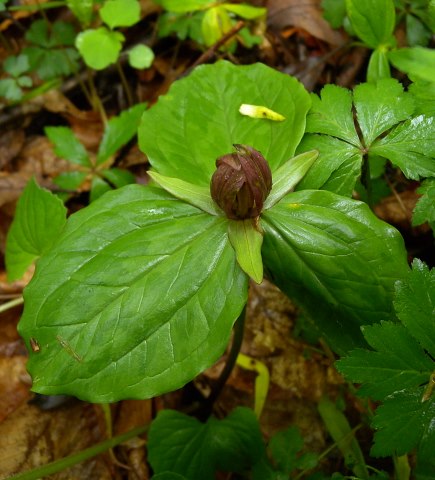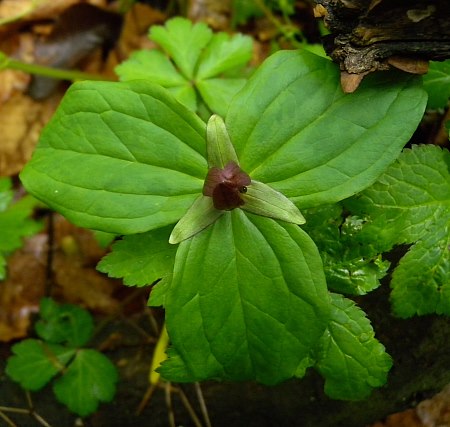Description: This herbaceous wildflower is 5-12" tall, consisting of a single stem and a whorl of 3 spreading leaves at its apex. The central stem is purplish green or maroon, terete, glabrous, and rather stout. Individual leaves are 3-4" long and 2-3½" across; they are ovate or oval, smooth along their margins, sessile, glabrous, and parallel-veined. The upper leaf surface is medium green or mottled green (a mixture of both light green and medium green). The leaf bases are rounded and their tips are usually blunt.

On a mature plant,
a single sessile flower develops on top of the whorl of leaves.
Individual flowers consist of 3 dark maroon petals about ¾-1¼" long
(rarely greenish yellow or brown), 3 green or purplish green sepals
about ½-1" long, 6 stamens about ½-¾" long, and an angular superior
ovary with 3 recurved stigmata at its apex. The erect petals are
narrowly elliptic to elliptic in shape. The sepals are narrowly
lanceolate and widely spreading to slightly ascending; they lie above
the plane of the leaves. The anthers have dark maroon and yellow
stripes; they are much longer than the filaments. The blooming period
occurs from mid- to late spring, lasting about 3 weeks. The flowers
usually have a slight aroma of rotting meat. Each flower is replace by
a dry 3-celled fruit that is whitish to purplish green. The fruit
splits open to release the seeds. The root system consists of a stout
rhizome and secondary fibrous roots. Clonal offsets occasionally
develop from the rhizome.
Cultivation:
The preference is dappled sunlight to light shade during the spring;
during the summer, more shade is tolerated. The soil should be moist,
rich, and loamy with abundant organic matter (decaying leaves, etc.).
This wildflower develops slowly from seed, requiring several years to
reach maturity. The seeds should be kept moist and planted as soon as
possible; they are often slow to germinate. It is also possible to
start plants from clonal offsets.
Range & Habitat:
The native Sessile Trillium is found primarily in NE and southern
Illinois, where it is uncommon. It is more common further to the east.
Habitats include rich mesic woodlands, floodplain woodlands in valleys,
lower slopes of shady ravines, and swamps. These habitats are dominated
by such deciduous canopy trees as Sugar Maple, American Beech, American
Basswood, and Green Ash. In Illinois, Sessile Trillium occurs in high
quality woodlands where the original ground flora is still intact.
Faunal Associations:
Robertson (1929) observed a small weevil, Centrinites
strigicollis, visiting the flowers for pollen. Because of the
malodorous odor and color of the petals, the flowers are probably
visited by beetles and flies that are attracted to rotting flesh. The
polyphagous caterpillars of two moths, Clepsis melaleucana
(Black-Patched Clepsis) and Euplexia benesimilis
(American Angle Shades), have been observed to feed on trilliums. The
seeds are distributed by ants (and possibly some beetles), which are
attracted to their elaisomes (food appendages). White-Tailed Deer
readily browse on the foliage of trilliums, although Sessile Trillium
may be eaten less often than some trillium species because of its
dark-colored and less conspicuous flowers.
Photographic Location:
A soggy area of Goff Woods Nature Preserve in NW Ohio. This woodlands
is a small remnant of what was once called the 'Great Black Swamp,'
which covered large areas of NW Ohio and NE Indiana.

Comments: In many ways, Sessile Trillium resembles the more common Prairie Trillium (Trillium recurvatum), which is also found in wooded habitats in Illinois. Sessile Trillium can be distinguished from the latter species by its sessile rounded leaves and widely spreading or ascending sepals, which are held above the leaves. In contrast, the leaves of Prairie Trillium taper gradually into petioles and the sepals of its flowers hang downward below the leaves. Both Sessile Trillium and Prairie Trillium can have flowers with greenish yellow petals, but this is rather uncommon. Other trilliums in Illinois have petals that are never colored dark maroon, or their flowers have conspicuous pedicels (flowering stalks). Other common names of Trillium sessile are Toadshade and Wake Robin.